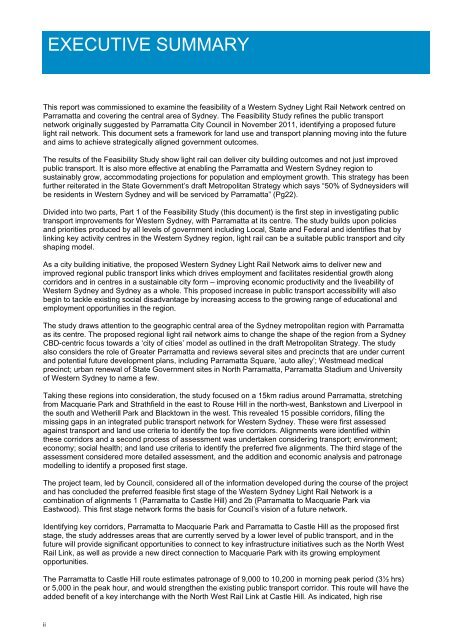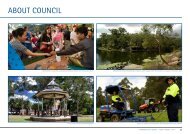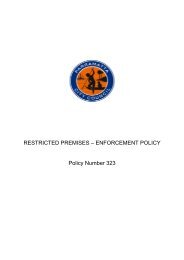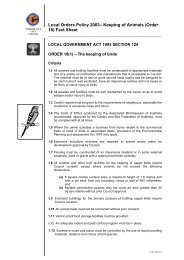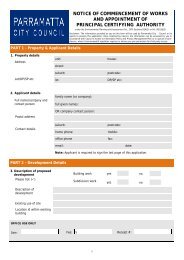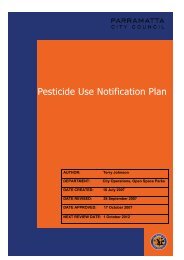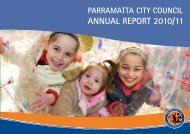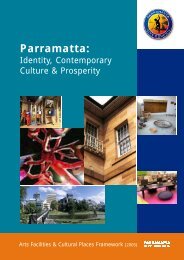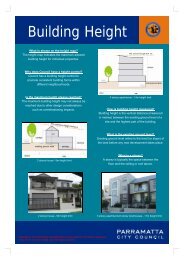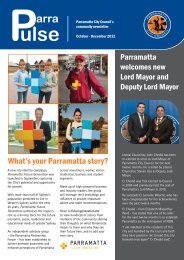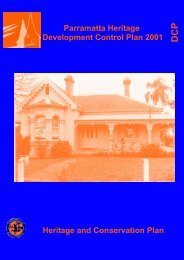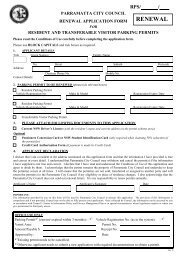Part 1 Western Sydney Light Rail Feasibility Report - Parramatta City ...
Part 1 Western Sydney Light Rail Feasibility Report - Parramatta City ...
Part 1 Western Sydney Light Rail Feasibility Report - Parramatta City ...
You also want an ePaper? Increase the reach of your titles
YUMPU automatically turns print PDFs into web optimized ePapers that Google loves.
EXECUTIVE SUMMARYThis report was commissioned to examine the feasibility of a <strong>Western</strong> <strong>Sydney</strong> <strong>Light</strong> <strong>Rail</strong> Network centred on<strong>Parramatta</strong> and covering the central area of <strong>Sydney</strong>. The <strong>Feasibility</strong> Study refines the public transportnetwork originally suggested by <strong>Parramatta</strong> <strong>City</strong> Council in November 2011, identifying a proposed futurelight rail network. This document sets a framework for land use and transport planning moving into the futureand aims to achieve strategically aligned government outcomes.The results of the <strong>Feasibility</strong> Study show light rail can deliver city building outcomes and not just improvedpublic transport. It is also more effective at enabling the <strong>Parramatta</strong> and <strong>Western</strong> <strong>Sydney</strong> region tosustainably grow, accommodating projections for population and employment growth. This strategy has beenfurther reiterated in the State Government’s draft Metropolitan Strategy which says “50% of <strong>Sydney</strong>siders willbe residents in <strong>Western</strong> <strong>Sydney</strong> and will be serviced by <strong>Parramatta</strong>” (Pg22).Divided into two parts, <strong>Part</strong> 1 of the <strong>Feasibility</strong> Study (this document) is the first step in investigating publictransport improvements for <strong>Western</strong> <strong>Sydney</strong>, with <strong>Parramatta</strong> at its centre. The study builds upon policiesand priorities produced by all levels of government including Local, State and Federal and identifies that bylinking key activity centres in the <strong>Western</strong> <strong>Sydney</strong> region, light rail can be a suitable public transport and cityshaping model.As a city building initiative, the proposed <strong>Western</strong> <strong>Sydney</strong> <strong>Light</strong> <strong>Rail</strong> Network aims to deliver new andimproved regional public transport links which drives employment and facilitates residential growth alongcorridors and in centres in a sustainable city form – improving economic productivity and the liveability of<strong>Western</strong> <strong>Sydney</strong> and <strong>Sydney</strong> as a whole. This proposed increase in public transport accessibility will alsobegin to tackle existing social disadvantage by increasing access to the growing range of educational andemployment opportunities in the region.The study draws attention to the geographic central area of the <strong>Sydney</strong> metropolitan region with <strong>Parramatta</strong>as its centre. The proposed regional light rail network aims to change the shape of the region from a <strong>Sydney</strong>CBD-centric focus towards a ‘city of cities’ model as outlined in the draft Metropolitan Strategy. The studyalso considers the role of Greater <strong>Parramatta</strong> and reviews several sites and precincts that are under currentand potential future development plans, including <strong>Parramatta</strong> Square, ‘auto alley’; Westmead medicalprecinct; urban renewal of State Government sites in North <strong>Parramatta</strong>, <strong>Parramatta</strong> Stadium and Universityof <strong>Western</strong> <strong>Sydney</strong> to name a few.Taking these regions into consideration, the study focused on a 15km radius around <strong>Parramatta</strong>, stretchingfrom Macquarie Park and Strathfield in the east to Rouse Hill in the north-west, Bankstown and Liverpool inthe south and Wetherill Park and Blacktown in the west. This revealed 15 possible corridors, filling themissing gaps in an integrated public transport network for <strong>Western</strong> <strong>Sydney</strong>. These were first assessedagainst transport and land use criteria to identify the top five corridors. Alignments were identified withinthese corridors and a second process of assessment was undertaken considering transport; environment;economy; social health; and land use criteria to identify the preferred five alignments. The third stage of theassessment considered more detailed assessment, and the addition and economic analysis and patronagemodelling to identify a proposed first stage.The project team, led by Council, considered all of the information developed during the course of the projectand has concluded the preferred feasible first stage of the <strong>Western</strong> <strong>Sydney</strong> <strong>Light</strong> <strong>Rail</strong> Network is acombination of alignments 1 (<strong>Parramatta</strong> to Castle Hill) and 2b (<strong>Parramatta</strong> to Macquarie Park viaEastwood). This first stage network forms the basis for Council’s vision of a future network.Identifying key corridors, <strong>Parramatta</strong> to Macquarie Park and <strong>Parramatta</strong> to Castle Hill as the proposed firststage, the study addresses areas that are currently served by a lower level of public transport, and in thefuture will provide significant opportunities to connect to key infrastructure initiatives such as the North West<strong>Rail</strong> Link, as well as provide a new direct connection to Macquarie Park with its growing employmentopportunities.The <strong>Parramatta</strong> to Castle Hill route estimates patronage of 9,000 to 10,200 in morning peak period (3½ hrs)or 5,000 in the peak hour, and would strengthen the existing public transport corridor. This route will have theadded benefit of a key interchange with the North West <strong>Rail</strong> Link at Castle Hill. As indicated, high riseii


